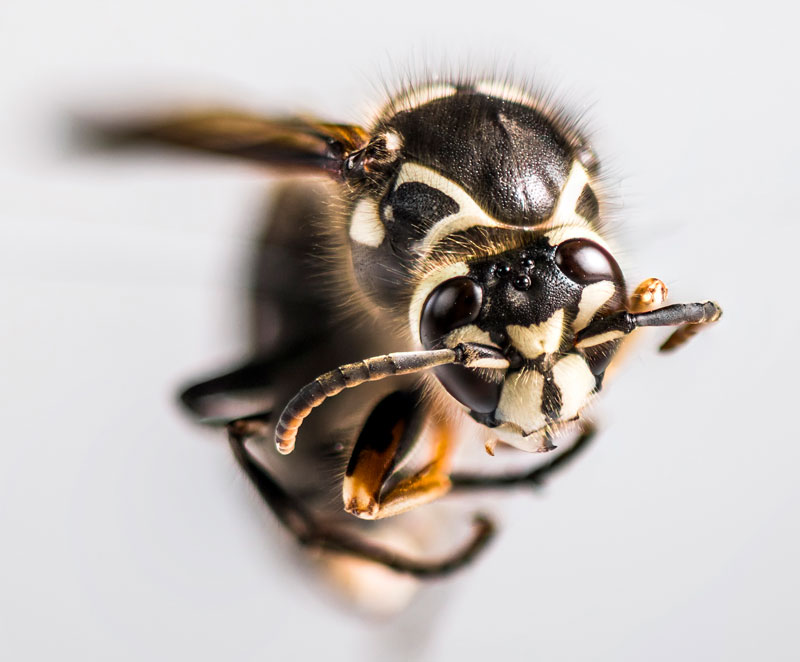What To Do About Stinging Insects
Imagine this scene: Friends and family have all gathered for the big cookout. Burgers are grilling, hot dogs are sizzling, drinks are flowing, people are having a great time. Suddenly, a small buzz that was maybe in the background becomes a roar, and a swarm of stinging insects descends on the party with a fury, throwing everything into chaos. Guests are running in every direction, babies are crying and screaming, pets are cowering under the table while scarfing up all the food that’s been dropped in the confusion.
This scenario is every backyard cook’s worse nightmare. But, thankfully, we can prevent it from happening with a little knowledge, a few smarts, and some luck. Here are the stinging insects you need to look out for if you want to avoid this situation.
Bees
Bees are probably the common stinging pest that comes to mind, yet most of them can and should be left alone. There are two main types of bees to know: bumble bees and honey bees. They’re sometimes confused for each other, but basically bumble bees are the typically fatter and furrier while honey bees are narrower and look more like wasps.
There’s been a lot of discussion recently about whether or not you should have these pests exterminated or treated, as they contribute to pollination and the health of our ecosystem. This is entirely true, but there are some situations when you need to treat an infested area: When bumble bees are nesting in an area of human activity and when honey bees are nesting in a structure. Swarms should generally be left alone, as they are most likely looking for a new place to live for the season.
Yellow Jackets
Yellow jackets are one of the most aggressive stinging insects we have in Maryland. The queens start to build their nests in April and will start to have workers appear on the nest around the third week of May depending on the weather. Yellow Jackets can build several different types of nests, including ground nests (watch where you walk!), aerial nests in trees or on the side of structures, and even inside a building or between its walls. Yellow jacket nests will reach between 1,000 and 5,000 workers in size and it’s not advisable for homeowners to treat these on their own. That said, yellow jackets are both pollinators as well as natural predators for some other unwanted pests, and while they can get mean when threatened, they can sometimes be left alone, depending on how much they interfere with your every day activities.
Hornets
There are two types of hornets to be aware of: the Baldfaced Hornet and the European Hornet.
Baldfaced Hornets are actually a type of Yellow Jacket. The markings on their head are black and white, with white being the dominant color, hence the name baldfaced. They build aerial nests that can be free hanging from a tree branch or up against the side of a building. Baldfaced Hornet nests can get extremely big, reaching the size of a large basketball. Nests are built starting in late April in Howard County and central Maryland. Baldfaced Hornet nests range in numbers from 250 to 500 workers. Baldfaced Hornets do not reuse their nests and build new ones every year. They are a particularly nasty breed of insect, as they are highly aggressive and can even shoot venom as well as sting! If you see a nest or even a handful of hornets, it’s highly advisable to stay away and call a professional for removal.
European Hornets, as the name suggests, were imported from Europe. Most people will describe these as large Yellow Jackets, as they are quite large compared to other wasps and hornets. While they are carnivorous, they are also highly aggressive, hunting for prey in both night and day. In fact they are the only social hornet/wasp/bee that is foraging at night in Howard and the surrounding counties. We get quite a few calls when they fly into garages or around decks at night as they are attracted to the exterior lights. European Hornets build void nests. We find them in attics quite a bit and hollow wall voids. Large nests can be up to a thousand strong, but they usually range in size of 200 to 400 workers.
 What To Do If You Have An Infestation
What To Do If You Have An Infestation
Stinging insect infestations like these are common throughout central Maryland, particularly during the summer. Don’t let these creatures ruin your fun, though! If you spot a nest or even a handful of these creatures, give us a call right away. We’ll investigate and recommend a suitable treatment that will ensure the safety of everyone who wants to enjoy your backyard this season.

Baldfaced Hornets are actually a type of Yellow Jacket. The markings on their head are black and white, with white being the dominant color, hence the name baldfaced. They build aerial nests that can be free hanging from a tree branch or up against the side of a building. Baldfaced Hornet nests can get extremely big, reaching the size of a large basketball. Nests are built starting in late April in Howard County and central Maryland. Baldfaced Hornet nests range in numbers from 250 to 500 workers. Baldfaced Hornets do not reuse their nests and build new ones every year. They are a particularly nasty breed of insect, as they are highly aggressive and can even shoot venom as well as sting! If you see a nest or even a handful of hornets, it’s highly advisable to stay away and call a professional for removal.
European Hornets, as the name suggests, were imported from Europe. Most people will describe these as large Yellow Jackets, as they are quite large compared to other wasps and hornets. While they are carnivorous, they are also highly aggressive, hunting for prey in both night and day. In fact they are the only social hornet/wasp/bee that is foraging at night in Howard and the surrounding counties. We get quite a few calls when they fly into garages or around decks at night as they are attracted to the exterior lights. European Hornets build void nests. We find them in attics quite a bit and hollow wall voids. Large nests can be up to a thousand strong, but they usually range in size of 200 to 400 workers.
 What To Do If You Have An Infestation
What To Do If You Have An Infestation
Stinging insect infestations like these are common throughout central Maryland, particularly during the summer. Don’t let these creatures ruin your fun, though! If you spot a nest or even a handful of these creatures, give us a call right away. We’ll investigate and recommend a suitable treatment that will ensure the safety of everyone who wants to enjoy your backyard this season.

